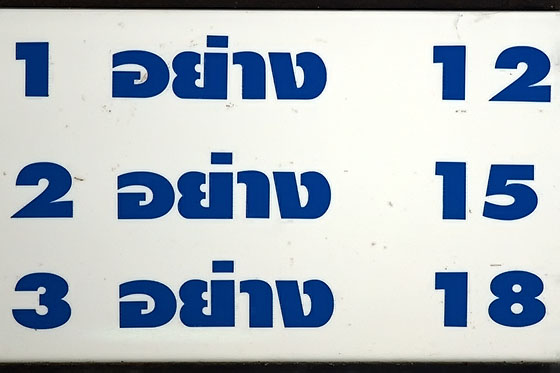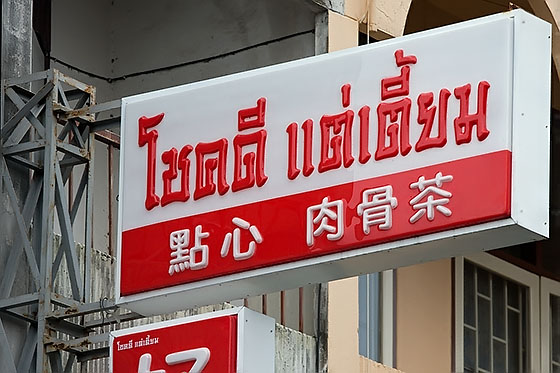Learn How To Read Thai - Tutorial 11
The Zero Consonant
I've been mentioning this frequently and have used it in a few examples but haven't explained it properly yet. The same character is used as a vowel in Thai (but called sara or). As a vowel it is used on its own or as part of a vowel combination.
The sound is more of an 'aw' than an 'or' if used on its own. Some of the vowel combinations it is used in are quite complex and I will cover them later.
It is also used as a 'zero consonant' (or aang). I actually explained this earlier but will explain it again here in more detail.
Some Thai vowels are written above or below the preceding consonant. But what if you want to start a syllable or word with a vowel sound? What can you write the vowel above or below if there is no preceding consonant?
That's where the 'zero consonant' comes in. You can use it at the start of a word that begins with a vowel sound. You now have something to write your vowel above or below but because it is a 'zero consonant' it makes no sound.
Technically speaking, the 'zero consonant' is only required for vowels that get written above or below a consonant but Thai uses the same convention for all vowels so that there is consistency.
It is also used at the beginning of four Thai words for similar reasons to why hor heep is used as a silent consonant. The Thai character hor heep changes the following consonant to high-class.
When the silent consonant is used this way it always precedes the low-class consonant yor yuk and changes it to mid-class.
It is also used on its own at the start of some words to make a short uh sound. Logically speaking, sara uh should be used for this purpose and because it is a vowel the 'zero consonant' should be used before it. However, the 'zero consonant' is just used on it own.
The examples below should start to make more sense.
อ
Name in Thai: อ อ่าง
Name in English: Or Aang (bowl)
Initial: -
Final: -
Class: Mid
Usage: Very common
Writing practice: Download Worksheet
Comments: See notes above and examples below.
Reading Practice
อร่อย (actual spelling)
This word says aroi. The silent consonant here at the beginning of the word (or aang) acts like the short vowel sara uh, and makes a short 'uh' sound. Why is it used? The vowel sound (uh) that starts this word cannot be written on its own. If we just want the vowel sound we need to use the silent consonant. What is extremely confusing with this word is that the actual vowel sound is implied and not written. Thai would be a LOT easier if all vowels were written, rather than implied, for example:
อะร่อย (better, but incorrect, spelling)
The spelling of the Thai word for 'what' (uh-rai) is much less confusing:
อะไร
The second syllable of aroi starts with the consonant ror reua, and then the same character as the first again, except that this time the exact same character is a vowel ( sara or) and not a consonant (or aang). The final consonant is yor yuk. The combination of or and yor yuk makes an 'oy' sound.
The word uh-roy means delicious in Thai. If you eat with Thais you will hear this word thousands of times.
Tone rules first syllable: There is no tone mark. It is a short, dead syllable and the consonant or aang is mid class. The tone according to the tone rules is low. (Tutorial 14).
Tone rules second syllable: Low-class initial consonant, first tone mark. The tone according to the tone rules is falling. (Tutorial 14)

As I wander around Thailand, I am always on the lookout for signs to supplement these tutorials. It's good to have real world examples because the fonts used on most signs are nothing like the fonts used on this website and in text books. The sign above is a good example of the 'zero consonant' because a zero consonant is used at the start of all three syllables.
Firstly, compare the font in the sign to the more conventional font used here:
อ้วน .. อึดอัด
Can you see how the little loops disappear and wor wairn resembles a backwards 'C'? When ror reua is written on signs it often looks like an English 'S'.
There are two stages involved when learning Thai. The first stage is to learn the basics from books and websites. The next stage is to work out which letters are which in the various fonts that are used in real-world Thailand.
The first word uses wor wairn as a vowel to make an 'oo-uh' sound (Tutorial 9) and the final consonant is nor noo, which makes an 'n' sound both as an initial and final consonant. Because the word starts with a vowel sound it needs a zero consonant. You can also see that the second tone mark goes above the zero consonant.
If it didn't have a zero consonant wor wairn would beome a 'W' consonant and the word would be 'wot' with an implied 'o' between the initial and final consonants.
The Thai word 'oo-un' is the adjective for fat, obese, overweight.
The next word has two syllables that both start with vowel sounds. Again, because the initial sound is a vowel both syllables require zero consonants.
The first syllable starts with the short 'eu' sound (Tutorial 27) and ends with dor dek, which has a 't' sound as a final consonant.
The second syllable starts with an 'uh' sound (mai-hun-aagaat) as in but, sun, cup, etc and also ends with dor dek.
Thus, we get eut ut, which means to feel uneasy or uncomfortable.
Tone Confusion And Spelling Irregularities
In addition to the tone rules, I have used various other sources to confirm tones.
The first syllable of aroi is low tone according to the tone rules, and accordingly Benjawan Poomsan Becker shows the first syllable of aroi and arai as low tone in the main text. However, she states at the front of her book that in the word arai the first syllable is commonly pronounced with a mid tone rather than a low tone. Robertson's Practical English-Thai Dictionary and David Smyth also indicate a mid tone for the first syllable of arai, even though this conflicts with the tone rules.
The second syllable of aroi should have a falling tone according to the tone rules, but both Benjawan and Robertson's Practical English-Thai Dictionary indicate a low tone.
The tone rules for aroi indicate low-falling tones, but depending which reference you use, you may see low-low or mid-low.
These discrepancies are fairly few and won't hinder your progress in learning to speak Thai. Be aware also that tones can also change as a result of the regional dialects used in Thailand. Is your base in Thailand in Isaan or in the deep south? The only way to improve your pronunciation is to listen to and copy the way that local Thais speak.
ก่อน
Hopefully, this is becoming quite easy for you now. The initial consonant is the hard 'g' sound gor gai. It is followed by sara or and finishes with nor noo. The character in this position is a vowel, rather than a zero consonant.
The pronunciation is more gawn than gorn but the best way to learn is to listen to a native speaker. It means before, ahead of, earlier, first.
Tone: Mid-class initial consonant, first tone mark = Low tone (Tutorial 14)
อยาก
This is one of the words where the zero consonant is used only for tone purposes. It makes no sound, unlike the 'uh' sound it makes at the beginning of uh-roy. The consonant yor yuk is low-class but adding the zero consonant before it makes yor yuk mid-class for tone rule purposes. The word begins with a 'y' sound, is followed by the long 'aa' vowel, and ends with an unreleased 'k' sound.
The Thai word yaak is used when you want to do something. Another verb (ao) is used when you want something.
Tone: Mid-class initial consonant, dead syllable, long vowel = Low tone (Tutorial 14)
Here's another example, this time of a real sign:

This is exactly the same as what I have described above where the zero consonant is used before yor yuk only for tone purposes. Also, like the example above, the long 'aa' vowel is used. However, this word ends with the 'ng' consonant (Tutorial 4) and the first tone mark is used.
We therefore get yaang. This basically means thing. The sign is a price list for food at a kaaw gairng and these are the prices depending on whether you have 1, 2 or 3 dishes (things) with your rice.
Tone: Mid-class initial consonant, first tone mark = Low tone (Tutorial 14)
อิ่ม
This word begins with the short vowel 'i' (which is always written above the preceding consonant) but there is no initial consonant to write it above. What do we do now? We use the zero consonant! The word ends with mor maa.
The Thai word im is the adjective 'to be full' from eating.
Tone: Mid-class initial consonant, first tone mark = Low tone (Tutorial 14)
อาหาร
This is another word that starts with a vowel sound - a long 'aa' vowel. Did you remember the rule? If a word or syllable starts with a vowel sound, we must write the zero consonant first. The first syllable is a long 'aa'.
The second syllable starts with hor heep, continues with another long 'aa' vowel and ends with ror reua. If you remember what I taught you in Tutorial 2 you will know that as a final consonant ror reua makes an 'n' sound.
The Thai word aa-haan means food.
Tone first syllable: Tone first syllable: According to the tone rules this is a low-tone but in normal, everyday speech the first syllable of poly-syllabic words is pronounced with a mid-tone.
Tone second syllable: High-class initial consonant, live syllable = Rising tone (Tutorial 14)
In many respects written Thai is much more phonetically correct than English. Yes there are more vowels and consonants, but there are different consonants for aspirated and unaspirated sounds whereas English uses only one consonant.
English only has five vowels, but it uses the same vowel and samew vowel combinations for different sounds. This must be terribly confusing for foreign learners of English. Why don't the words 'but' and 'put' rhyme with each other.
Why doesn't 'food' rhyme with 'foot'? Foreign learners of Thai have a big advantage because Thai uses different vowels, consonants and vowel combinations for different sounds.
There is one vowel for the 'oo' sound in 'food' and another for the 'oo' sound in 'foot. Here are the vowels. They are written below the consonant and for these examples I will use the zero consonant.
อุ - this short 'uu' sound is the same sound as 'oo' in 'foot' and 'u' in 'put'.
Writing practice: Download Worksheet
อู - this long 'oo' sound is the same sound as 'oo' in 'food' and 'u-e' in 'rude'.
Writing practice: Download Worksheet
These vowels will be covered more in tutorial (Tutorial 18).
See if you can read the following sign. The first word begins with a vowel sound and therefore starts with the zero consonant. It should be very clear now why the zero consonant is required. The initial vowel is always written underneath the preceding consonant and without the zero consonant there would be nothing to write it under. In this word the final short vowel (which happens to be the same as the initial vowel) isn't voiced.
If your pronunciation is something like uu-but-dti-het (accident) you are getting the hang of reading Thai.
A very observant reader suggested that I should explain the spelling of this word. Firstly, it starts with a vowel sound, which creates a problem for some vowels. Certain Thai vowels are written above or below the initial consonant and for words that start with a vowel sound, rather than a consonant sound, where do you put them if there is no initial consonant? The Thai solution is to use the 'or aang' zero consonant. The initial vowel sound is the short 'uu', as in 'put' or 'foot'.
Bor bai mai is next and above it is mai-hun-aagaat followed by dtor dtao so that the second syllable is 'but'.
With some multi-syllabic Thai words, a single consonant can be used as the final consonant of one syllable and the initial consonant of the next. Remember that the same letters can have different sounds depending on whether they are initial or final consonants, so be careful if you find that a single consonant ends one syllable and starts another.
Here's an example:
ผลไม้ - pon-luh-mai (fruit)
ผ - por peung (bee) makes a 'P' sound as both an initial and final consonant. It will be covered in Tutorial 17).
A single lor ling consonant ends the first syllable and starts the second. As an initial consonant it makes an 'l' sound, but as a final consonant it makes an 'n' sound. The first and second syllables both have implied vowels.
Getting back to our original word, so far we have 'uu-but'. The dtor dtao is used as the initial consonant of the third syllable with the short i vowel, so that we get dti.
The fourth and final syllable is confusing. Sara ay has two sounds. It can be like the 'ay' in 'hay' or the 'e' in hen.
เล่น - len (to play)
เวลา - way-laa (time)
In this case it is more like 'het' than 'hate' - uu-but-dti-het.
Finally, Thai words that come from other languages are often spelt in such a way as to preserve the original spelling, but the spurious characters can be confusing. Words of Indic origin often have silent short final vowels, such as the name of Bangkok's airport that is transliterated as Suvarnabhumi, but pronounced 'suu-wun-na-poom' with no final 'i'.
The final short sara uu in uu-but-dti-het can be ignored. How do you know? The answer is that you don't. How do you know that cough is pronounced coff? You just know from experience. It's the same with Thai.
This is starting to sound horribly complicated and I hope that it doesn't put anyone off.
The second word (emergency) is chuuk chern. This is the Accident and Emergency room of my local hospital.

Important Note About Poly-Syllabic Words
I have been using standard tone rules in these examples and for many poly-syllabic words the first tone, according to the tone rules, is low.
However, Benjawan Poomsan Becker advises that in normal speech the first syllable is mid tone. Written Thai is quite logical and follows set rules most of the time but there are some anomalies and this appears to be one of them.
Questions And Feedback
If you have any comments, questions or suggestions, feel free to contact me. Your feedback will help me to improve these pages.
Recommended Books
Amazon UK
Amazon UK
Amazon US
Amazon US

